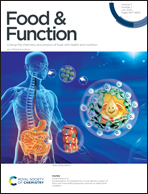Gallic acid reduces the viscosity and water binding capacity of soluble dietary fibers
Abstract
Water binding capacity and viscosity of soluble dietary fibers are known to be essential drivers of their nutritional benefits. Phenolic compounds, often found in the presence of dietary fibers, are also known to bind non-covalently with soluble dietary fibers. In this study, we characterized the impact of gallic acid (1–30 mM) on the physical properties of four soluble dietary fibers in solution (0.75% w/w oat β-glucans with medium and high molecular weights, 0.75% w/w guar galactomannan and 0.5% w/w xanthan mannoglucuronoglucan). Isothermal titration calorimetry and particle size analysis showed that gallic acid and soluble dietary fibers formed poorly dissociable non-covalent complexes, leading to colloidal aggregation of the fibers. Upon complexation, the physical properties of the fibers changed dramatically with up to a 65% increase in water mobility (reflecting a dramatic decrease in water binding capacity), up to a 41% increase in pseudo-plastic behavior leading to near-Newtonian behavior, and up to a 95% decrease in viscosity. This suggests that combinations of free phenolic compounds and soluble dietary fibers may be detrimental to the physical and potentially the nutritional properties of the fibers.

- This article is part of the themed collection: Food & Function Recent HOT articles


 Please wait while we load your content...
Please wait while we load your content...